Abstract
The Sombor index is defined as , where and represent the number of edges in the graph G connected to the vertices u and v, respectively. In this paper, we characterize the largest and second largest Sombor indexes with a given number of cut edges. Moreover, we determine the upper and lower sharp bounds of the Sombor index with a given number of clique numbers, and we characterize the extremal graphs.
MSC:
05C35
1. Introduction
In graph theory, studying extremal graphs and indices for a class of graphs with given parameters is an interesting problem. Recently, Gutman introduced a novel topological index, named the Sombor index in [1] and defined as , where and represent the number of edges connected to vertices u and v in G, respectively, and further established some mathematical properties for the index. Chen et al. in [2] considered the extremal values of the Sombor index of trees with some given parameters such as matching number, pendent vertices, diameter, segment number, and branching number. In the meantime, the corresponding extremal trees are characterized. Li et al. showed the extremal graphs with respect to the Sombor index among all the n-order trees with a given diameter [3]. In [4], Redžpović studied the chemical applicability of the Sombor index. In addition, Cruz et al. in [5] determined the extremal chemical graphs and hexagonal systems for the Sombor index. In [6], Zhou et al. studied the Sombor index of trees and unicyclic graphs with a given maximum degree. In [7], they found the maximum Sombor index of unicyclic graphs with a fixed girth. In [8], they showed applications of the Sombor index. For more studies in this direction, one may refer to [9,10,11,12,13,14,15,16,17,18,19,20,21,22,23,24].
Let be a finite, simple, and connected graph with and . For any vertex , we denote and . The degree of the vertex v is the number of edges connected to the vertex v. The vertex v is called pendent vertex if . The stem is the vertex adjacent to at least one pendent vertex, and the pendent edge is the edge incident with the pendent vertex and the stem. If , then the distance is the length of the shortest path connecting the two vertices u and v. We use , and to represent the path, cycle, and star graph with n vertices, respectively.
A clique is a subset that makes to a complete graph. The order of the largest complete subgraph in graph G is called the clique number of G. The chromatic number of the graph G is the minimum number of colors needed to stain each vertex on a graph so that the two adjacent vertices are different colors. See reference [25] for some notations and terms that we have not mentioned here.
Let be a class of graphs having n vertices and k cut edges. Denote . It can be divided into two classes, namely, pendent edges with size , and non-pendent edges with size . We know the resulting graph are either 2-edge-connected graphs or isolated vertices. The maximum number of cut edges in a connected graph with n vertices and at least one cycle is limited to ; therefore, we assume that the graph G with cut edges and k () is less than or equal to .
In this paper, we determine the Sombor index of the graph with a given number of cut edges and determine the types of the graphs with the largest and second largest Sombor indexes. At the same time, we use clique number to determine the upper and lower sharp bounds for the Sombor index in . We will introduce some graph transformations.
2. The Extremal Graph of the Sombor Index with Cut Edges
If any graphs and with , then label the graph as . If the graphs share a common vertex v, then the graph is labeled as . In the same way, if there is a cut edge between any graphs and with and , in the same way, we label this graph as . According to the definition and direct computation, we can obtain the following results.
Lemma 1.
Let be a graph and . If is not an edge in , we have . If is an edge in , then we have .
Proof.
Since the increase (or decrease) in a new edge in the graph increases (or decreases) by some vertex degree, the lemma obviously holds. □
Here, we explain the graph transformation I on graph . Denote that is a graph that does not contain cut edge , where and are both 2-edge-connected graphs (Figure 1a). Let (Figure 1b). Then, the resulting graph is obtained from G via the graph transformation I. Since the graph posses k cut edges, the number of pendent vertices increases by 1.
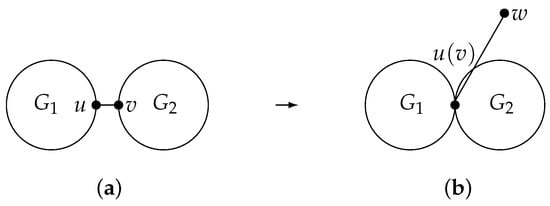
Figure 1.
The graph transformation I: . (a) G. (b) .
Lemma 2.
Suppose that is the graph derived by using the graph transformation I, as described in Figure 1. Then, .
Proof.
Set and with . Then, , , and . It is clear that the vertices are in ; and are in by assumption. Further,
Note that
where and . We have finished. □
Here, we explain the graph transformation II on a graph . Set as not a pendent cut edge in , Figure 2a. Let (Figure 2b). In this way, the graph is attained at G by applying graph transformation II.

Figure 2.
The graph transformation II: . (a) G. (b) .
Based on the graph transformation II, we obtain:
Lemma 3.
Let be a 2-edge-connected graph and be a non-pendent cut edge of ; will be the resulting graph from G by applying the graph transformation II (Figure 2). Then, we have .
Either a cut edge or a non-pendent edge can be transformed into a pendent edge via graph transformations I and II, as shown in Figure 3.
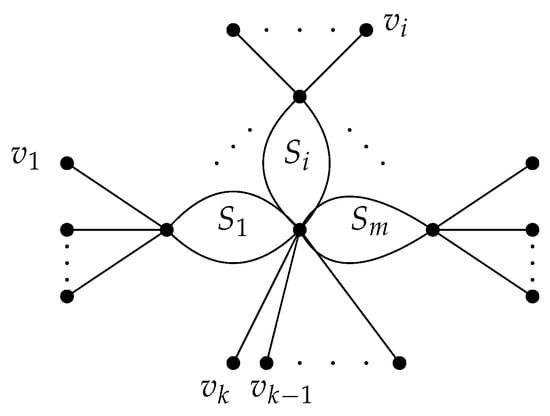
Figure 3.
The graph .
Here, we explain the graph transformation III on graph . Assume that and the vertices are pendent vertices adjacent to vertex u; the vertices are pendent vertices adjacent to vertex v, as shown in Figure 4a. Let , as shown in Figure 4b. Then, is the resulting graph from G through graph transformation III.

Figure 4.
The graph transformation III: . (a) G. (b) .
Lemma 4.
Let be a graph obtained from G by applying the graph transformation III (Figure 3). Then, .
By repeating this transformation in the graph, all pendent edges are connected to the same vertex.
We will discuss the graph of with the largest Sombor index in the following. Let be a complete graph with n vertices, and be a graph obtained by connecting k independent vertices to one of the vertices of .
Theorem 1.
In all connected graphs in , the Sombor index takes the maximum value on , i.e., the graph obtained by connecting k independent vertices to one of the vertex of the graph .
Proof.
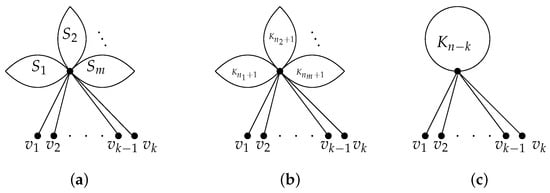
According to above lemmas, we provide the Sombor index for graphs in that achieve the upper bound.
Claim 1. If a graph , then .
Let and , then based on the above lemmas, we know . Obviously, the equality holds when .
Claim 2. For two graphs and H in Figure 4, , the equality holds when .
Assume is a graph with cut edges . Then, via Lemma 1, we have , where . Recall that by adding some edges to 2-edge-connected graphs for , it is converted to the complete subgraphs ; therefore, the graph is converted to the graph H, which has k cut edges, so that . According to Lemma 1, if , then we have and the equality holds when .
Claim 3. For two graphs H and in Figure 5, we have , and the equality holds when , i.e., .

Figure 5.
Simple graphs , H and with k cut edges. (a) . (b) H. (c) .
The graph H becomes the graph if we connect every pair of vertices in the complete subgraphs of H and it has k cut edges. Obviously, and . Therefore, using Lemma 1, we obtain , and the equality holds when , i.e., .
With the above three claims, the theorem holds. □
In the following, we characterize the graph with the second largest Sombor index in .
Theorem 2.
In all graphs and , it holds that ; the equality holds when .
Proof of Theorem 2.


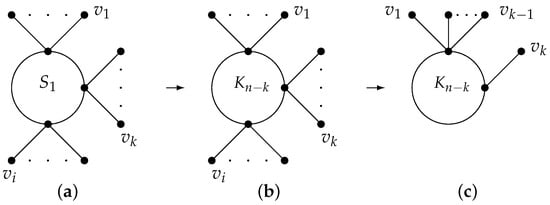
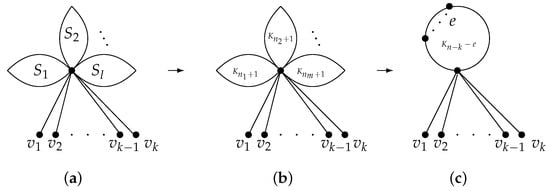
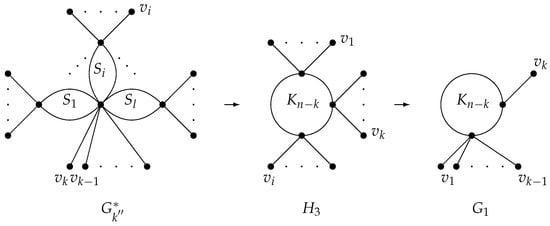
For all graphs , if G achieves the maximum , then it must be one of the graphs shown in Figure 6, namely , or .

Figure 6.
Simple graphs , , and with cut edges. (a) . (b) . (c) .
Recall that either a cut edge or a non-pendent cut edge can eventually be transformed into a pendent edge by repeating the graph transformation I or II. We denote the resulting graph as in Figure 3, where for represents the 2-edge-connected graphs. Then, we have . In Figure 3, represents the number of non-pendent vertices attached to cut edges. In the following, we will discuss two cases according to parameters m and .
Case 1. If .
If , additional edges are added to the vertices of the subgraph which is 2-edge-connected; via transformation, turns into or (see Figure 7). By adding an additional edge to either or , then it becomes the graph . Therefore, based on the Lemma 1, it holds that

Figure 7.
The graphs with , . (a) . (b) . (c) .
If , edges are initially added to the vertices of the which is a 2-edge-connected subgraph, and it is converted to , denoting the graph as (See Figure 8). By applying Lemma 1, we obtain . Next, repeating the graph transformation III on graph H, at last we obtain . If we move only one edge from , it becomes . By repeating this transformation in the graph, each pendent edge is attached to the same vertex. Via Lemma 4, we have

Figure 8.
The graph transformation with , . (a) . (b) . (c) .
Case 2. If , we consider the same way in Case 1.
If , the complete graphs are constructed by adding edges to the 2-edge-connected subgraphs in , forming the graph (Figure 9). Then, we have via Lemma 1. Add some edges between , composing the graph (Figure 9). If adding another edge to , it becomes . Via Lemma 1, it holds that

Figure 9.
The graph transformation with , . (a) . (b) . (c) .
If , add some edges to of to obtain the complete graph ; by adding edges among , we can obtain the graph . Finally, we can obtain the graph by applying the graph transformation III on , and we can obtain the graph by adding an edge to (Figure 10). Then, according to the above lemmas, it holds that .

Figure 10.
The graph transformation with , .
From the above cases, we know that the second largest value of the Sombor index is taken by one of the graphs , and . In our next work, we only need to compare the Sombor index of , and . Therefore,
Therefore, we compare the graph with the graph , where and , then, through direct calculation, we have .
Next, we compare the graph with the graph using easy calculation, where and , then . Therefore, the Sombor index attained the maximum value on . The theorem is proven. □
3. Extremal Sombor Index of Graphs with a Clique Number
Let and be a class of graphs with n vertices, and chromatic number k and clique number k, respectively.
Let be a complete k-partite graph with a partition set differing in size by no more than 1. Let be the graph in which a vertex of a a complete graph is connected to a path graph (see Figure 11). Next, we will prove that the graph and the tadpole graph has a maximal and minimal Sombor index in , respectively.
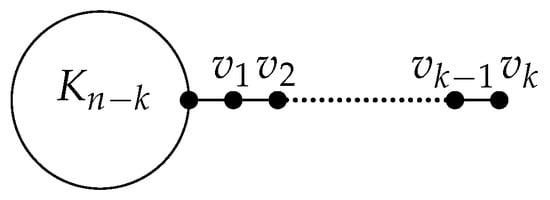
Figure 11.
The tadpole graph .
In order to obtain our main result, we first provide some necessary lemmas. From the definition of the Sombor index of the graph, these lemmas are obvious and fundamental.
Assume that . Set as the complete k-partite graph with n vertices, and the number of the partition set as , respectively.
Lemma 5.
Proof.
In a partition set of size of for , the degree of each vertex is between two partition sets of sizes , where , respectively. In , there are edges connected to two sets. In addition, the degrees of the two vertices incident with each of these edges are and , respectively. Then, we have , and we complete the proof of the lemma. □
In the next, we consider the maximal Sombor index of graphs from . The set contains connected graph when , and the only graph in is the complete graph when .
Lemma 6.
Let be the graph with a maximal Sombor index. Then, .
Proof.
The lemma holds immediately based on Lemma 1, and by the definition of the set . □
Further, we will introduce some notations. If are not the same vertices in graph G for , we denote by the graph from G by attaching a path of length p and q at the vertex u and v of G, respectively. For , let be the graph attaining at v a path of length l. Let , and through the graph transformations, we get the following Lemma:
Lemma 7.
Let G be a connected graph with ; v is a vertex in G. is the graph resulting from attaching at v two paths of lengths k and , respectively. Then, .
By repeating the above lemma, it is easy to obtain the following result.
Remark 1
([6]). When the tree T with t vertices on the graph G is replaced by the path , then of the graph decreases.
Remark 2
([6]). Assume , and two vertices so that . Then, .
Now, we first consider the maximal Sombor index for a graph from . In the discussion in this part, we assume that the graph G has k chromatic numbers for and , , where .
Lemma 8.
Let , then
where the first equality holds when .
Proof.
For any graph , there are k color classes, and each color class is an independent set. If the order of k classes is , according to Lemma 6 and by , it takes the maximal Sombor index, which is the complete k-partite graph . Suppose that a graph takes the maximal Sombor index. We claim that G is . On the contrary, suppose that and represent the size of vertices of two classes, , such that . Let if for convenience. Thus, using Lemma 5, we obtain:
Let
Then, we have
Therefore,
This contradicts the maximality of the Sombor index of G. We know that . Combining with Lemma 5, the values of Sombor index can be obtained immediately. □
Lemma 9
([26]). Assume that is the graph, . Then, there is a k-partite graph , and it holds that for .
According to the above lemmas, we obtain:
Theorem 3.
Let . Then,
the equality holds when .
Proof.
It is trivial that when , then we assume that . Assume that G from has the maximum Sombor index. Let . If not, from the case of Lemma 9, we obtain the k-partite graph with the same set of vertices as G makes , . Clearly, . According to the definition, we obtain . According to Lemma 8, this theorem holds immediately due to the uniqueness of extremal graphs in . □
Theorem 4.
Let , then , where equality holds when .
Proof.
Assume that the graph has the smallest Sombor index. Using the definition of , has a subgraph , which is a complete graph. Let . Via Lemma 1, is a graph obtained via by connecting some trees rooted in some vertices of . From , let , (i.e., there is a tree connected to for any vertex , and vertices in are labeled as , with .
From Lemma 9, all trees connected to some vertices of must be paths in , i.e., all vertices of of have degree k. Suppose that . Contrary to assumption, we can find two vertices at least, such that . The graph is denoted by . However, from the graph transformation, is converted into or with a smaller Sombor index. In this way, it contradicts the choice of . Hence, , and through simple calculation, we have
This theorem is proven. □
4. Conclusions
In this paper, firstly, we determine the Sombor index of the graph with a given number of cut edges and we determine the types of graphs with the largest and second largest Sombor indexes through the graph transformations I, II, and III. Secondly, we use the clique number to characterize the extremal graphs for the Sombor index, and we provide the upper and lower bounds for the index. As a result, we provide the following results in Table 1.

Table 1.
Main results.
5. Notations
We provide some symbols in Table 2 in the following.

Table 2.
Notations.
Author Contributions
These authors contributed equally to this work. All authors have read and agreed to the published version of the manuscript.
Funding
This work is supported by the Research Fund of Xinjiang University of Finance and Economics (2022XGC068); the Base Tender Project of Humanities, Social Sciences, funded by the Ministry of Education (ZX20230042); and is sponsored by the Natural Science Foundation of Xinjiang Uyghur Autonomous Region (2023D01A72).
Institutional Review Board Statement
Not applicable.
Informed Consent Statement
Not applicable.
Data Availability Statement
Data are contained within the article.
Acknowledgments
The authors are very grateful to the anonymous referees and editors for their constructive suggestions and insightful comments, which have considerably improved the presentation of this paper.
Conflicts of Interest
The authors declare no conflicts of interest.
References
- Gutman, I. Geometric approach to degree-based topological indices: Sombor Indices. MATCH Commun. Math. Comput. Chem. 2021, 86, 11–16. [Google Scholar]
- Chen, H.; Li, W.; Wang, J. Extremal values on the Sombor index of trees. MATCH Commun. Math. Comput. Chem. 2022, 87, 23–49. [Google Scholar] [CrossRef]
- Li, S.; Wang, Z.; Zhang, M. On the extremal Sombor index of trees with a given diameter. Appl. Math. Comput. 2022, 416, 126731. [Google Scholar] [CrossRef]
- Redžepović, I. Chemical applicability of Sombor indices. J. Serb. Chem. Soc. 2021, 86, 445–457. [Google Scholar] [CrossRef]
- Cruz, R.; Gutman, I.; Rada, J. Sombor index of chemical graphs. Appl. Math. Comput. 2021, 399, 126018. [Google Scholar] [CrossRef]
- Zhou, T.; Lin, Z.; Miao, L. The Sombor index of trees and unicyclic graphs with given maximum degree. Discret. Math. Lett. 2021, 7, 24–29. [Google Scholar]
- Senthilkumar, B.; Venkatakrishnan, Y.B.; Balachandran, S.; Ali, A.; Alraqad, T.A.; Hamza, A.E. On the Maximum Sombor Index of unicyclic graphs with a fixed girth. J. Math. 2022, 2022, 8202681. [Google Scholar] [CrossRef]
- Réti, T.; Došlić, T.; Ali, A. On the Sombor index of graphs. Contrib. Math. 2021, 3, 8–11. [Google Scholar]
- Kulli, V.R.; Gutman, I. Computation of Sombor indices of certain networks. Int. J. Appl. Chem. 2021, 8, 1–5. [Google Scholar]
- Lin, Z.; Zhou, T.; Kullic, V.R.; Miao, L. On the first Banhatti-Sombor index. J. Int. Math. Virtual Inst. 2021, 11, 53–58. [Google Scholar]
- Zhao, W.; Yaping, M.; Yue, L.; Furtula, B. On relations between Sombor and other degree-based indices. J. Appl. Math. Comput. 2021, 68, 1–17. [Google Scholar]
- Liu, H. Proof of an open problem on the Sombor index. J. Appl. Math. Comput. 2023, 69, 2465–2471. [Google Scholar] [CrossRef]
- Alikhani, S.; Ghanbari, N. Sombor Index of Polymers. MATCH Commun. Math. Comput. Chem. 2021, 86, 715–728. [Google Scholar]
- Hayat, S.; Rehman, A. On Sombor index of graphs with a given number of cut-vertices. MATCH Commun. Math. Comput. Chem. 2023, 89, 437–450. [Google Scholar] [CrossRef]
- Horoldagva, B.; Xu, C. On Sombor index of graphs. MATCH Commun. Math. Comput. Chem. 2021, 86, 703–713. [Google Scholar]
- Cruz, R.; Rada, J. Extremal values of the Sombor index in unicyclic and bicyclic graphs. J. Math. Chem. 2021, 59, 1098–1116. [Google Scholar] [CrossRef]
- Liu, H.; Lu, M.; Tian, F. On the spectral radius of graphs with cut edges. Linear Algebra Appl. 2004, 389, 139–145. [Google Scholar] [CrossRef]
- Hayat, S.; Arshad, M.; Gutman, I. Proofs to some open problems on the maximum Sombor index of graphs. J. Appl. Math. 2023, 42, 279–289. [Google Scholar] [CrossRef]
- Cruz, R.; Rada, J.; Sigarreta, J.M. Sombor Index of trees with at most three branch vertices. Appl. Math. Comput. 2021, 409, 126–414. [Google Scholar] [CrossRef]
- Chen, S.B.; Liu, W.J. Extremal Zagreb indices of graphs with a given number of cut edges. Graphs Comb. 2014, 30, 109–118. [Google Scholar] [CrossRef][Green Version]
- Xiang, X. The Zagreb indices of graphs with a given clique number. Appl. Math. Lett. 2011, 24, 1026–1030. [Google Scholar]
- Gutman, I.; Furtula, B. Novel Molecular Structure Descriptors-Theory and Applications I; University of Kragujevac: Kragujevac, Serbia, 2010. [Google Scholar]
- Zhao, Q.; Li, S.C. On the maximum Zagreb indices of graphs with k cut vertices. Acta Appl. Math. 2010, 111, 93–106. [Google Scholar] [CrossRef]
- Das, K.C.; Çevik, A.S.; Cangul, I.N.; Shang, Y. On Sombor index. Symmetry 2021, 13, 140. [Google Scholar] [CrossRef]
- Bondy, J.A.; Murty, U.S.R. Graph Theory and Its Applications; Macmillan: London, UK; Elsevier: New York, NY, USA, 1976. [Google Scholar]
- Erdös, P. On the graph theorem of Turán. Math. Fiz. Lapok 1970, 21, 249–251. [Google Scholar]
Disclaimer/Publisher’s Note: The statements, opinions and data contained in all publications are solely those of the individual author(s) and contributor(s) and not of MDPI and/or the editor(s). MDPI and/or the editor(s) disclaim responsibility for any injury to people or property resulting from any ideas, methods, instructions or products referred to in the content. |
© 2024 by the authors. Licensee MDPI, Basel, Switzerland. This article is an open access article distributed under the terms and conditions of the Creative Commons Attribution (CC BY) license (https://creativecommons.org/licenses/by/4.0/).